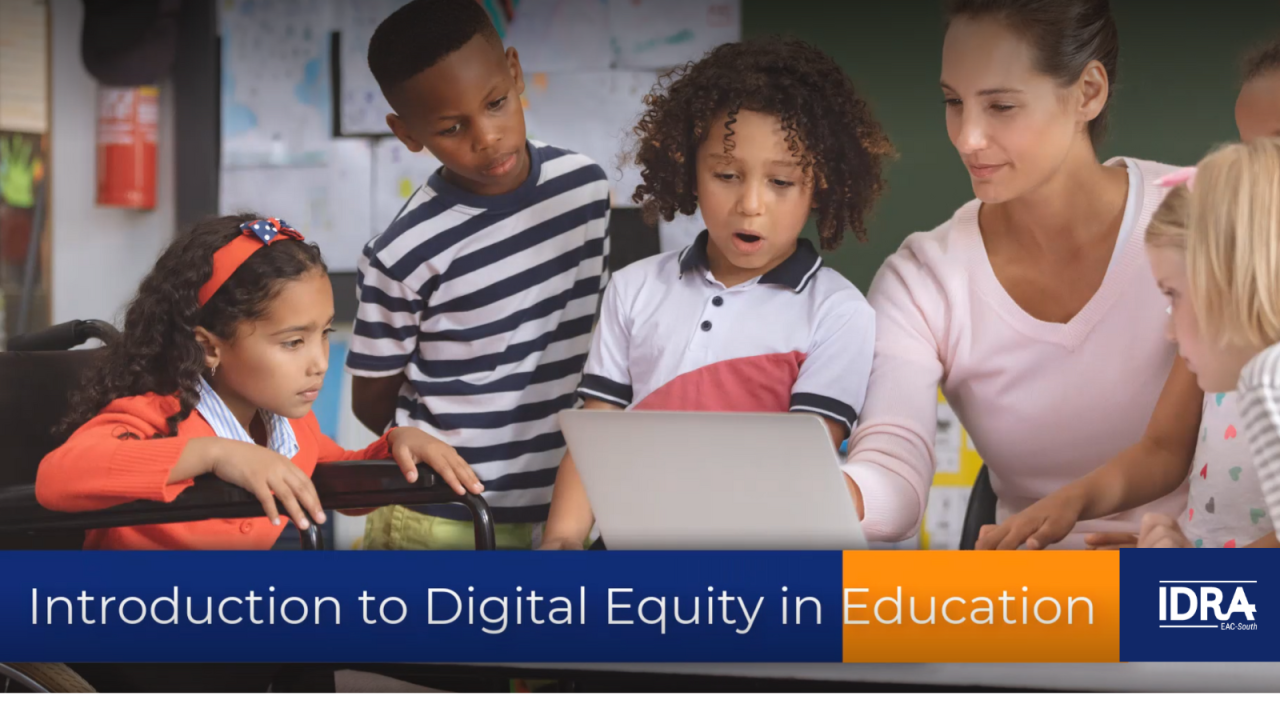How to Support Digital Equity in Education is a vital conversation in today’s tech-driven world. As education increasingly relies on digital tools, ensuring that every student has equal access to technology becomes essential. This not only enhances learning opportunities but also bridges gaps caused by socioeconomic disparities. By understanding the significance of digital equity, we can better address the challenges faced by students and educators alike.
From identifying barriers to access, recognizing affected demographics, and exploring successful initiatives, this discussion will offer valuable insights into creating a more inclusive educational environment. It’s important for educators, parents, and policymakers to collaborate and implement effective strategies that promote digital equity.
Understanding Digital Equity in Education
Digital equity refers to the fair and just access to digital tools, resources, and opportunities necessary for effective learning in educational settings. In an increasingly technology-driven world, ensuring that all students and educators have equal access to these digital resources is crucial for fostering an inclusive and equitable educational environment. The significance of digital equity lies not only in providing access to devices and internet connectivity but also in ensuring that all learners can effectively utilize technology to enhance their educational experiences.Barriers to digital equity often stem from socioeconomic disparities that limit access to technology and the internet.
Factors such as income level, geographic location, and educational background can create significant hurdles for students and educators. For instance, students from low-income households may lack reliable internet access or necessary devices, while rural areas might have insufficient infrastructure to support high-speed internet. These barriers hinder the ability of both students and educators to engage fully in digital learning environments.
Demographics Affected by Digital Inequity
Several demographic groups are particularly affected by digital inequity, highlighting the need for targeted interventions. It is essential to understand who is impacted to address these disparities effectively. The following demographics are often at a disadvantage:
- Low-Income Families: Families with limited financial resources often struggle to provide their children with access to devices and reliable internet, significantly impacting their educational outcomes.
- Rural Communities: Students in rural areas frequently face challenges related to limited internet connectivity and access to technology, which can hinder their participation in online learning.
- Minority Groups: Students from historically marginalized racial and ethnic backgrounds may encounter systemic barriers that limit their access to digital resources and opportunities.
- Students with Disabilities: Learners with disabilities may require specific technological adaptations that are not always readily available, leading to further inequities in access and support.
The implications of digital inequity extend beyond access; they also encompass the quality of educational experiences and outcomes. Recognizing these demographics is vital for developing strategies and policies that promote digital equity in education.
“Digital equity is not just about access to technology; it’s about ensuring all students can leverage digital tools to enhance their learning and achieve their full potential.”
In summary, digital equity in education serves as a critical foundation for fostering inclusive learning environments. Addressing the barriers faced by various demographics can lead to a more equitable educational landscape for all students.
Current Initiatives Supporting Digital Equity
In the quest for digital equity in education, numerous initiatives have emerged to address the disparities in access to technology and the internet. These programs are designed to ensure that all students, regardless of their socioeconomic background, have the tools they need to succeed in a digital world. By examining successful examples of these initiatives, we can gain insight into how collaboration and funding can bridge the digital divide.One of the most notable examples of a successful program is the EveryoneOn initiative, which focuses on connecting low-income families to affordable internet services and digital literacy resources.
Since its inception, EveryoneOn has partnered with various organizations, schools, and local governments to provide access to low-cost broadband, helping to empower families with the knowledge and resources they need to utilize technology effectively.
Successful Programs Bridging the Digital Divide
Several organizations and initiatives have made significant strides in promoting digital equity. Their efforts highlight the importance of access and education in today’s digital landscape. Key initiatives include:
- Digital Promise: This organization works to close the digital equity gap by providing resources and support for educators, schools, and communities. Their initiatives include the “Digital Equity Collaborative,” which focuses on sharing best practices and fostering partnerships.
- Tech Goes Home: Operating in various cities, this program provides training, devices, and low-cost internet access to families. Since 2000, Tech Goes Home has successfully equipped thousands of families with the skills and tools needed for digital engagement.
- ConnectHomeUSA: An initiative by the U.S. Department of Housing and Urban Development, ConnectHomeUSA aims to close the digital divide in public housing. By partnering with local governments and private companies, it provides affordable broadband access and digital literacy training to low-income families.
Organizations and Partnerships Advancing Digital Equity
Numerous organizations are dedicated to advancing digital equity through collaborative efforts and partnerships. These stakeholders play a crucial role in supporting various initiatives:
- Common Sense Media: Known for its advocacy for children’s rights in the digital age, Common Sense Media provides resources and support for educators and families to promote digital literacy and responsible technology use.
- The National Digital Inclusion Alliance (NDIA): This organization is at the forefront of promoting digital inclusion policies and practices, offering guidance to communities striving to enhance digital equity.
- Local Education Agencies (LEAs): Many LEAs have developed partnerships with tech companies and nonprofits to provide students with the necessary devices and internet access, fostering equitable learning environments.
Funding Sources and Grants for Digital Equity Initiatives
Securing funding for digital equity initiatives is vital for their sustainability and growth. Various funding sources and grants are available to support programs aimed at bridging the digital divide:
- Federal Grants: The federal government offers several grants aimed at increasing broadband access and digital literacy through programs like the E-Rate program, which helps schools and libraries obtain affordable telecommunications services.
- Private Foundations: Organizations such as the Bill & Melinda Gates Foundation and the Knight Foundation have invested millions in digital equity initiatives, providing essential funding to support programs that enhance technology access in underserved communities.
- State and Local Grants: Many states and localities have developed their own grant programs to fund digital equity initiatives, often aimed at local nonprofits and educational institutions working directly with impacted communities.
“Bridging the digital divide is not just about technology; it’s about empowering communities with the resources and skills they need to thrive in an increasingly digital world.”
Tools and Resources for Educators
The integration of digital tools in education is vital for fostering an inclusive learning environment. These resources not only enhance student engagement but also ensure that every learner has equal access to educational opportunities. Understanding and utilizing these tools can significantly support teachers in promoting digital equity.
Digital Tools Promoting Accessibility and Inclusivity
Various digital tools are designed to make learning more accessible for all students, including those with disabilities. Implementing these tools in the classroom can help bridge the gap in educational equity.
- Screen Readers: Tools like JAWS and NVDA assist visually impaired students by reading text aloud, allowing them to access digital content.
- Speech-to-Text Software: Applications such as Dragon NaturallySpeaking enable students to dictate their thoughts, making writing tasks more accessible.
- Text-to-Speech Tools: Programs like NaturalReader convert written text into spoken words, helping students with reading difficulties.
- Digital Notebooks: Tools like OneNote and Evernote allow students to organize notes and lessons in a way that suits their learning style.
- Assistive Technology Apps: Apps like Proloquo2Go provide communication support for students with speech disabilities, enabling them to express their thoughts more freely.
Best Practices for Integrating Technology into Lesson Plans
Incorporating technology within lesson plans requires a strategic approach to ensure that it enhances learning outcomes. Educators can follow several best practices to achieve effective integration.
- Align Technology with Learning Objectives: Ensure that any technology used directly supports the lesson’s goals, enhancing student understanding and engagement.
- Encourage Collaborative Learning: Use tools like Google Classroom or Padlet to foster collaboration among students, allowing them to work together on projects and share ideas.
- Differentiate Instruction: Leverage technology to tailor learning experiences to meet diverse student needs, offering varied resources that cater to different learning styles.
- Provide Continuous Feedback: Utilize platforms such as Kahoot or Quizizz to assess student understanding in real-time and adjust teaching methods accordingly.
Resources for Professional Development in Digital Equity
Professional development is crucial for educators to stay updated on the latest tools and strategies to promote digital equity in their classrooms. Several resources are available to support their growth.
- Online Courses: Websites like Coursera and edX offer free and paid courses focused on digital equity, accessibility, and effective technology integration in education.
- Webinars and Workshops: Organizations such as the International Society for Technology in Education (ISTE) provide regular webinars that address current trends and practices in digital equity.
- Networking Communities: Joining online forums and social media groups, such as those on Twitter or LinkedIn, can connect educators with peers passionate about digital equity.
- Educational Conferences: Attending events like the EduTech Conference allows educators to learn from experts in the field and share best practices with colleagues.
Community Involvement and Engagement: How To Support Digital Equity In Education
Engaging the community is vital for fostering digital equity in education. Schools, parents, and community members must collaborate to create an inclusive environment that supports students’ diverse digital needs. By pooling resources and knowledge, communities can ensure that every student has access to the technology and digital resources necessary for academic success.Community members play an essential role in supporting digital equity.
Their involvement can take various forms, and schools can harness this involvement through strategic initiatives. Here are some effective strategies for engaging parents and community members:
Strategies for Involving Parents and Community Members
Encouraging active participation from parents and community members can have a significant impact on digital equity initiatives. Schools can implement the following strategies to involve them effectively:
- Organize workshops that educate parents on digital tools, resources, and internet safety, helping them support their children’s learning at home.
- Create volunteer programs that allow parents and community members to assist in technology-related initiatives, such as tutoring or mentoring students.
- Establish a communication platform, such as newsletters or social media groups, to keep parents informed about school initiatives and encourage their feedback and participation.
Collaboration with Local Businesses and Organizations
Partnering with local businesses and organizations is a powerful way to enhance digital equity. Schools can explore various collaboration methods to strengthen the community’s support for students:
- Develop internship or mentorship programs that connect students with local businesses, providing them with real-world experience and insights into various industries.
- Seek donations of technology, software, or services from businesses to help bridge the gap in access to digital resources for students.
- Collaborate with local nonprofits focused on education or technology to create community events that raise awareness and promote digital equity initiatives.
Raising Awareness about Digital Equity in Communities
Raising awareness about digital equity is crucial to garnering community support and driving change. Schools can adopt the following methods to promote understanding and engagement within their communities:
- Host community forums or town hall meetings that bring together stakeholders to discuss the importance of digital equity and share success stories from local initiatives.
- Utilize social media campaigns to highlight the challenges faced by students regarding digital access and the benefits of community involvement in addressing these issues.
- Create informative materials, such as brochures or infographics, that Artikel the significance of digital equity and suggest ways for community members to get involved.
Policy Recommendations
Advocating for policies that support digital equity is crucial for creating an inclusive educational environment where all students have access to the tools they need to succeed. Policies can help bridge the gap in technology access, ensuring that disparities due to socioeconomic status, geography, or other factors do not hinder educational opportunities. By implementing effective strategies, schools and communities can work together to promote digital equity and empower all learners.
Developing a digital equity plan requires a structured approach that encompasses various aspects of technology access and usage. Schools should consider their unique contexts, the specific needs of their students, and the resources available to them. A comprehensive digital equity plan can be a guiding framework for educators and institutions striving to enhance access to technology.
Framework for Digital Equity Plans
A well-defined framework is essential for schools to create effective digital equity plans. This framework can include several key components:
1. Assessment of Current Technology Access
Evaluate the existing technology infrastructure, including hardware, software, and internet connectivity available to students and staff. Identifying gaps and areas for improvement is essential to inform future decisions.
2. Needs Analysis
Conduct surveys and focus groups with students, parents, and educators to understand the specific challenges faced in accessing technology. This input can guide targeted interventions to support digital equity.
3. Strategic Partnerships
Establish collaborations with local businesses, nonprofits, and government agencies to enhance resources and share best practices. Partnering with organizations that specialize in technology can help schools access tools and training that they may lack.
4. Professional Development for Educators
Ensure that teachers receive ongoing training in digital tools and resources. Equipping educators with the knowledge to integrate technology effectively into their classrooms is vital for fostering an equitable learning environment.
5. Monitoring and Evaluation
Develop metrics to assess the progress and effectiveness of the digital equity initiatives. Regularly reviewing the plan allows for adjustments and improvements based on feedback and changing needs.
“Creating a digital equity plan is not a one-time effort, but an ongoing commitment to ensure all students have the tools necessary for their educational journey.”
Role of Government in Ensuring Equitable Access
Government plays a pivotal role in promoting digital equity in education. Through legislation and funding initiatives, governments can create the conditions necessary for equitable access to technology. Key areas of focus include:
Funding and Grants
Providing financial support for schools to improve their technology infrastructure is essential. Governments can allocate funds specifically for technology upgrades, internet access expansion, and digital literacy programs.
Policy Development
Crafting policies that prioritize digital equity ensures that educational institutions adhere to best practices. This includes setting standards for internet access, technology use in classrooms, and ensuring that marginalized communities receive targeted support.
Advocacy for Universal Internet Access
Governments can work to expand broadband access in underserved areas, recognizing that reliable internet is a fundamental requirement for modern education. Initiatives such as the FCC’s E-Rate program aim to connect schools and libraries with affordable internet service.
Collaboration with Stakeholders
Engaging various stakeholders in the educational landscape, including parents, community organizations, and tech companies, fosters a comprehensive approach to addressing digital equity challenges. Collaborative efforts can yield innovative solutions to complex problems.
In fulfilling these roles, government entities can help create a more equitable educational environment where all students, regardless of their circumstances, can thrive in a digital world.
Future Trends in Digital Equity
As we look ahead, the landscape of digital equity in education is bound to transform dramatically. Emerging technologies and societal shifts are set to reshape how equitable access to digital resources is realized. Understanding these trends will be crucial for educators, policymakers, and communities aiming to foster an inclusive educational environment.
Emerging Technologies Impacting Digital Equity
Technological advancements are continuously evolving, and their integration into education presents both opportunities and challenges. Some key technologies that are likely to impact digital equity include:
- Artificial Intelligence (AI): AI can personalize learning experiences, making education more accessible to diverse learners. Tools powered by AI can adapt to individual learning paces and styles, bridging gaps for students who may struggle in traditional settings.
- Virtual and Augmented Reality (VR/AR): These technologies can create immersive learning environments, allowing students from various backgrounds to engage in hands-on experiences that may not be available in their physical locations.
- 5G Connectivity: The rollout of 5G networks promises faster internet speeds and improved connectivity, which can significantly reduce the digital divide, especially in rural and underserved areas.
- Open Educational Resources (OER): The increase in freely accessible educational materials can democratize learning opportunities, ensuring that students from all socioeconomic backgrounds have access to high-quality content.
Potential Challenges and Opportunities
As we embrace new technologies, certain challenges and opportunities will emerge that could influence the trajectory of digital equity in education.
Challenges include:
- Digital Literacy: As technology evolves, ensuring that both students and educators possess the necessary skills to effectively use new tools remains a significant hurdle.
- Data Privacy Concerns: The integration of advanced technologies raises important questions about the security and privacy of student data, necessitating robust policies to protect users.
- Equitable Access to Technology: While advancements can enhance learning, disparities in access to devices and high-speed internet persist, threatening the goal of true equity.
Conversely, opportunities are abundant:
- Innovative Funding Models: Crowdfunding and public-private partnerships may provide financial support for technology implementation in underfunded schools.
- Community Engagement: Increased collaboration between schools and local organizations can foster a greater sense of shared responsibility for student success and resource accessibility.
- Policy Advocacy: There is potential for stronger advocacy movements aimed at ensuring equitable funding and policies for digital resources in education.
Evolution of Digital Equity Initiatives
The future of digital equity initiatives will likely evolve in response to ongoing societal changes, including demographic shifts and technological advancements.
Examples of these changes may include:
- Increased Focus on Inclusivity: As awareness of diverse learning needs grows, initiatives aimed at supporting neurodiverse learners or those with disabilities will become more prominent.
- Integration of Social-Emotional Learning (SEL): Digital equity initiatives may increasingly incorporate SEL frameworks to support not only academic growth but also emotional well-being, recognizing the whole child.
- Global Collaboration: The interconnectedness brought about by technology may lead to more international partnerships focused on sharing resources and best practices for achieving digital equity in education worldwide.
Case Studies and Success Stories

Digital equity in education is not just a concept; it is a transformative movement that has taken root in various schools across the globe. These case studies illustrate how institutions have effectively implemented digital equity solutions, showcasing the real-world impact on students and educators. Through innovative approaches and community engagement, these schools have created inclusive environments where all learners can thrive.
Successful Implementation in Schools
Numerous schools have adopted various strategies to ensure digital equity is not just a goal but a reality. Here are a few standout examples:
- Springfield High School: This institution introduced a 1:1 device program, providing every student with a personal tablet. The initiative was accompanied by training sessions for teachers on integrating technology into their lessons. A survey showed that 85% of students felt more engaged in their learning due to the availability of digital resources.
- Greenwood Middle School: In collaboration with local nonprofits, Greenwood established a community Wi-Fi network to ensure that all families, regardless of their economic status, had internet access. This initiative notably increased student participation in online learning, with attendance rates rising by 20% during remote learning phases.
- Lakeside Academy: Lakeside implemented a mentorship program where tech-savvy high school students assist their peers and younger students with digital literacy. This peer-led approach not only enhanced skills but also fostered a sense of community and support among students.
Testimonials from Educators and Students
The voices of those directly impacted by digital equity initiatives provide invaluable insight into their effectiveness. Here are some notable testimonials:
“Access to technology has completely changed the way my students learn. They are more engaged, excited, and curious than ever before.” Ms. Johnson, 5th Grade Teacher at Springfield High School.
“I used to struggle with homework because I didn’t have internet at home. Now that my school provides it, I can do my assignments and even explore new topics!”
Alex, 8th Grader at Greenwood Middle School.
These testimonials highlight the positive outcomes of implementing digital equity strategies, confirming that access to technology and the internet significantly enhances learning experiences.
Comparative Approaches to Promote Digital Equity, How to Support Digital Equity in Education
Different schools have taken varied approaches to champion digital equity. Understanding these differences can shed light on effective strategies that others might adopt.
| School Name | Approach | Key Outcome |
|---|---|---|
| Springfield High School | 1:1 Device Program | Increased student engagement and academic performance. |
| Greenwood Middle School | Community Wi-Fi Access | Enhanced attendance rates and participation in online learning. |
| Lakeside Academy | Peer Mentorship Program | Improved digital literacy and community support among students. |
Through these case studies and testimonials, it becomes evident that the pathways to achieving digital equity in education are diverse. The effectiveness of these initiatives depends on local needs, resources, and community involvement, all contributing to a shared goal of ensuring every student has the opportunity to succeed in a digital world.






